J.R.R. Tolkien had a fascination with hidden kingdoms and cities. As one reads through his works they can be seen everywhere, throughout the ages and in a variety of forms. Many things these hidden realms have in common and all have their own symbolism; many are bastions of hope against an ever present dark foe, others are places that are ignorant of any darkness and simply exist in bliss and wonder and are overlooked. Some are tucked away in a valley or at the base of a mountain range; while others are deep in dense and impenetrable forests either with natural or supernatural defenses. Some are carved straight out of the stone or delved deep into the earth, and others…well a few even existed right out in the open.
Tolkien’s love of things being tucked away and only talked about in rumor or in private circles is fascinating. He wove it into almost all of his stories and made the reader feel like they were in on a secret that no one else was. Almost everything that was hidden for Tolkien was noble and good; by contrast everything that was evil was right out in the open. Tolkien made a situation where evil was ever present and out in plain sight, things that were good needed to be kept hid and held onto tightly; and many of his stories involved characters whose actions were motivated by wanting to save or destroy these precious hidden things.
Let’s discuss these hidden realms directly in contradiction with their shadowy counterparts. They exist in all parts of Middle-earth that are covered by Tolkien’s stories, they are present in all three ages of time, and there is always an evil realm wanting to spoil them. There are hidden realms outside of Middle-earth as well, in the far west in Aman but that is a discussion for another time, we’ll stick to Middle-earth. I’ve decided to use the term realm as it encompasses all of the areas I’d like to discuss, some are kingdoms others are refuges, while some are villages. I believe that Tolkien uses this contrast to more clearly define the light from the darkness.
 In the ancient days of the first age there were three hidden kingdoms of elves Doriath, Nargothrond, and Gondolin. All three of the kingdoms were shrouded in secrecy in one way or another from the dark lord Morgoth. His realm, far to the north was named Angband, and it was unapologetically out in the open. Everybody knew where Morgoth was: elves, men, and the Valar. It was so well known that all the great battles of the first age took place under the shadow of Angband, the Noldor even laid siege to it for nearly four hundred years. Morgoth was constantly sending out orcs and other fell creatures to wreak havoc on Beleriand to the south and among these were spies trying to find out the location of the three hidden kingdoms.
In the ancient days of the first age there were three hidden kingdoms of elves Doriath, Nargothrond, and Gondolin. All three of the kingdoms were shrouded in secrecy in one way or another from the dark lord Morgoth. His realm, far to the north was named Angband, and it was unapologetically out in the open. Everybody knew where Morgoth was: elves, men, and the Valar. It was so well known that all the great battles of the first age took place under the shadow of Angband, the Noldor even laid siege to it for nearly four hundred years. Morgoth was constantly sending out orcs and other fell creatures to wreak havoc on Beleriand to the south and among these were spies trying to find out the location of the three hidden kingdoms.
 What is the symbolism of Angband, with its peaks of Thangorodrim out in the open awaiting challengers? What is Tolkien saying about evil here? Angband is described in this way, “Outwardly, Angband was a large terrible place built into Thangorodrim. Before the Great Gate, there was a sombre court area flanked by frightening cliffs and walled by great towers of a great battlement. Through the gate, there was a long great tunnel leading to a ‘labyrinthine pyramid’ of stairs to corridors, tunnels, smithy chambers which a tall chimney went up through the mountain to the smokey towers of Thangorodrim that spewed poisonous fumes for hundreds of years. There were also many tunnels leading to the slave quarters or vaults. All tunnels of course led to Morgoth’s throne in the Nethermost Hall” Atlas of Middle-earth, Karen Fonstad.
What is the symbolism of Angband, with its peaks of Thangorodrim out in the open awaiting challengers? What is Tolkien saying about evil here? Angband is described in this way, “Outwardly, Angband was a large terrible place built into Thangorodrim. Before the Great Gate, there was a sombre court area flanked by frightening cliffs and walled by great towers of a great battlement. Through the gate, there was a long great tunnel leading to a ‘labyrinthine pyramid’ of stairs to corridors, tunnels, smithy chambers which a tall chimney went up through the mountain to the smokey towers of Thangorodrim that spewed poisonous fumes for hundreds of years. There were also many tunnels leading to the slave quarters or vaults. All tunnels of course led to Morgoth’s throne in the Nethermost Hall” Atlas of Middle-earth, Karen Fonstad.
To draw answers to this question about the realm one need only to look at its master. Morgoth fashioned himself king of Arda, with his goal being to control the entire physical world. However no one else called him this because he never came close to achieving his goal. This evil realm is a symbol of compensation, evil compensating for its inadequacy against the power of righteousness. Morgoth must prove to all the inhabitants of Middle-earth that he is their master; his only real tools in this effort are brute force and the showing of power. What better way to display that power than to build a fortress out in the open and challenge those to better it? Shadow cannot create what light has; Angband is a perfect example of jealousy leading to audacity of building.
When looking at building audacity from a more positive perspective, the ancient kingdom of the Grey Elves in Doriath takes the cake. “A vault of topless trees it seemed, whose trunks of carven stone there stood like towers of an enchanted wood in magic fast for ever bound, bearing a roof whose branches wound in endless tracery of green lit by some leaf-imprisoned sheen of moon and sun, and wrought of gems, and each leaf hung on golden stems” JRR Tolkien Lay of Leithian.
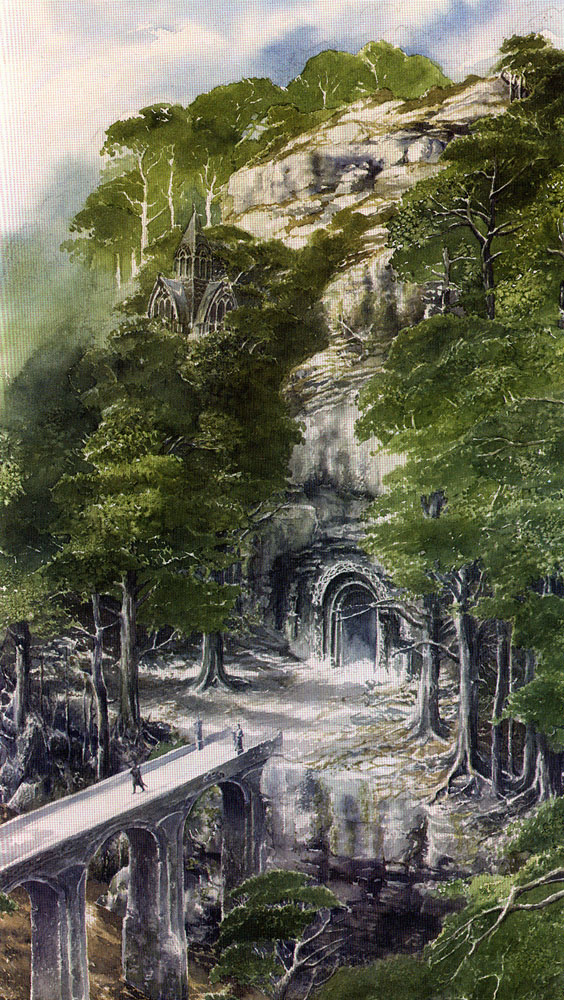 With its capital Menegroth being the work of elven and dwarvish cooperation creating a work of splendor that was never again equaled in Middle-earth, this realm needed super natural protection. Luckily, king Thingol’s wife Melian, a Maiar, shrouded all of Doriath with her powers, locking it away from evil. Menegroth is a symbol of harmony and cooperation between the free beings of Middle-earth, Elves, Dwarves, and Maiar. Tolkien is showing us what can happen when we work together, by cooperating with one another the peoples of Middle-earth created the most spectacular kingdom east of the sea in ancient days. This realm is hidden not with its location, but with kindness of heart and sacrifice of body. Melian’s protective shield comes from the love she bears Middle-earth and the elves of Doriath often leave their kingdom to fight Morgoth in the north sacrificing their bodies in the process. But even as the symbol of cooperation that Doriath is, its downfall will be the forgetting of that purpose by its inhabitants. Doriath and Menegroth in particular will be consumed not from without but from within, as its most important resident King Thingol unwittingly tears that partnership asunder through hubris and greed.
With its capital Menegroth being the work of elven and dwarvish cooperation creating a work of splendor that was never again equaled in Middle-earth, this realm needed super natural protection. Luckily, king Thingol’s wife Melian, a Maiar, shrouded all of Doriath with her powers, locking it away from evil. Menegroth is a symbol of harmony and cooperation between the free beings of Middle-earth, Elves, Dwarves, and Maiar. Tolkien is showing us what can happen when we work together, by cooperating with one another the peoples of Middle-earth created the most spectacular kingdom east of the sea in ancient days. This realm is hidden not with its location, but with kindness of heart and sacrifice of body. Melian’s protective shield comes from the love she bears Middle-earth and the elves of Doriath often leave their kingdom to fight Morgoth in the north sacrificing their bodies in the process. But even as the symbol of cooperation that Doriath is, its downfall will be the forgetting of that purpose by its inhabitants. Doriath and Menegroth in particular will be consumed not from without but from within, as its most important resident King Thingol unwittingly tears that partnership asunder through hubris and greed.
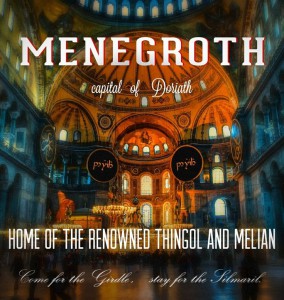 “After the return of the Noldor to Middle-earth, King Thingol described the Caverns to his kinsman Finrod. Inspired by Menegroth in Doriath, and seeking a hidden place from which to be safe from the forces of Morgoth, Finrod chose those caves to build his great underground fortress, and established Nargothrond. He was aided by the Dwarves of the Ered Luin, who also made for him the Nauglamir, the Necklace of the Dwarves and gave him his famous surname, Felagund, Hewer of Caves. Finrod rewarded them with treasures he brought from Tirion” JRR Tolkien The Silmarillion.
“After the return of the Noldor to Middle-earth, King Thingol described the Caverns to his kinsman Finrod. Inspired by Menegroth in Doriath, and seeking a hidden place from which to be safe from the forces of Morgoth, Finrod chose those caves to build his great underground fortress, and established Nargothrond. He was aided by the Dwarves of the Ered Luin, who also made for him the Nauglamir, the Necklace of the Dwarves and gave him his famous surname, Felagund, Hewer of Caves. Finrod rewarded them with treasures he brought from Tirion” JRR Tolkien The Silmarillion.
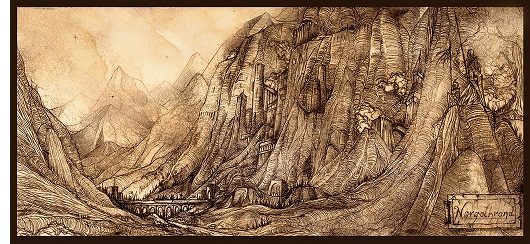
If the wonder and splendor of Menegroth represents cooperation between the inhabitants of Middle-earth, then the hidden kingdom of Nargothrond must mean something similar as it was modeled on that city. Nargothrond is similar in almost every way to Menegroth right down to the help of the dwarvish ability with stone work. What does this mean? Why would Tolkien invent a similar, but smaller kingdom with the same framework?
I believe the aspect of good and light that Tolkien is describing with this realm is its ability to learn and replicate itself. Nargothrond is a carbon copy of Menegroth, good is multiplying itself for survival insurance against the malice of the north. Nowhere else in Tolkien’s stories does evil replicate in this fashion, in fact it isn’t allowed to replicate this way. Morgoth and Sauron are micro-managers of others and would never tolerate copy cat realms challenging their authority. One can also see Nargothrond as tribute to its parent structure, much like the pyramids of the Giza plateau, with one built after the other as a copy and tribute to the one before it. The Noldorian inhabitants even copy the defensive strategy of Doriath, while they have no magic girdle they fan out and protect their perimeter from intruding orcs and other fell beasts. If the downfall of Doriath was the pride of an elf, the downfall of Nargothrond was the pride of a man, the pride of Turin, convincing the elves of that realm to build a bridge across the river Narog compromising their defenses and leading to the invasion of Glaurung.
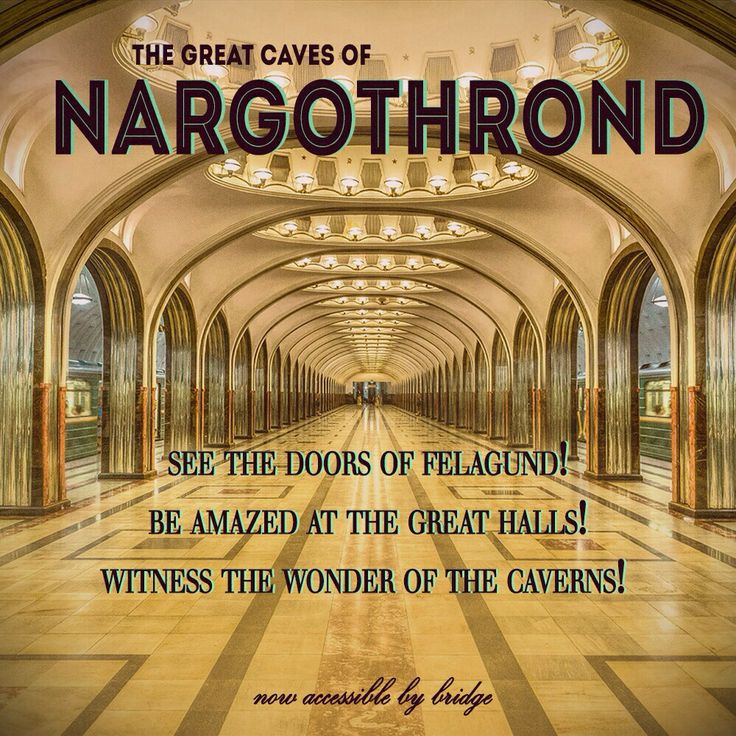 “…Then they looked up and could see, and lo! they were at the foot of steep hills, and these hills made a great circle wherein lay a wide plain, and set therein, not rightly at the midmost but rather nearer to that place where they stood, was a great hill with a level top, and upon that summit rose a city in the new light of the morning…” JRR Tolkien, The History of Middle-earth Vol II.
“…Then they looked up and could see, and lo! they were at the foot of steep hills, and these hills made a great circle wherein lay a wide plain, and set therein, not rightly at the midmost but rather nearer to that place where they stood, was a great hill with a level top, and upon that summit rose a city in the new light of the morning…” JRR Tolkien, The History of Middle-earth Vol II.
 Gondolin was the fairest city and best kept secret in Middle-earth throughout all of Tolkien’s stories. It went by many names; it was the original white shining city on a hill, long before Minas Anor (Tirith) was conceived. It’s easy to see Tolkien’s reverence for Gondolin, one can feel his joy when reading the description of it as the words simply fly off the page. Gondolin has similar origins to Nargothrond as both are founded by the sons of Fingolfin spurred on by a divine message from Ulmo, one of the Valar. Whereas Nargothrond is a copy of Menegroth, Gondolin is more of a model of a kingdom from Valinor, as Tolkien readily states in the text that Turgon its king, wanted to replicate that which he had left behind when the Noldor departed.
Gondolin was the fairest city and best kept secret in Middle-earth throughout all of Tolkien’s stories. It went by many names; it was the original white shining city on a hill, long before Minas Anor (Tirith) was conceived. It’s easy to see Tolkien’s reverence for Gondolin, one can feel his joy when reading the description of it as the words simply fly off the page. Gondolin has similar origins to Nargothrond as both are founded by the sons of Fingolfin spurred on by a divine message from Ulmo, one of the Valar. Whereas Nargothrond is a copy of Menegroth, Gondolin is more of a model of a kingdom from Valinor, as Tolkien readily states in the text that Turgon its king, wanted to replicate that which he had left behind when the Noldor departed.
The symbolism of Gondolin does not lie in its stonework or its location hidden by the encircling mountains. This realm’s symbolism lies more with its inhabitants than anything else and king Turgon’s own laws. This is the ability of the side of light to be prudent and structured, unyielding in its moral and legal code. Turgon never allows anyone to leave Gondolin and very few are ever allowed to come in to the city, in order to keep its location hidden from Morgoth. This careful and unbending code is what allows Gondolin to be the gold standard of the kingdoms of the elder days. And it’s no surprise that the traits that allowed these elves to have the finest kingdom of the first age were the same ones their author held in such high esteem in his own life, Tolkien being a prudent conservative himself. One only needs to compare the three to see the advantage, Gondolin has the geographic and divine protection with the mountains and the eagles of Manwe guarding the secret entrance while Nargothrond has only the geographic protection and Doriath has only the divine protection. However this does not stop Gondolin from falling, the same as Doriath and Nargothrond before it, again greed and pride rear their ugly heads this time in the form of the nephew of King Turgon, betraying his city to Morgoth after being rejected by the one he lusted after.
It’s interesting the great lengths that Tolkien goes to with the differentiation of the great realms of the first age yet at the same time the commonalities abound and are so obvious. All three need protection from Angband in the north and achieve it in the ways stated. All three use the landscape and the steadfastness of their inhabitants to some degree to ward off the dark menace. They all fall in succession with one another Nargothrond first, then Doriath, and finally and most tragically Gondolin. Each of the realms fall is preceded by the appearance of a stranger in their midst: Turin in Nargothrond, Hurin in Doriath, and Tuor in Gondolin. What is the symbolism here? 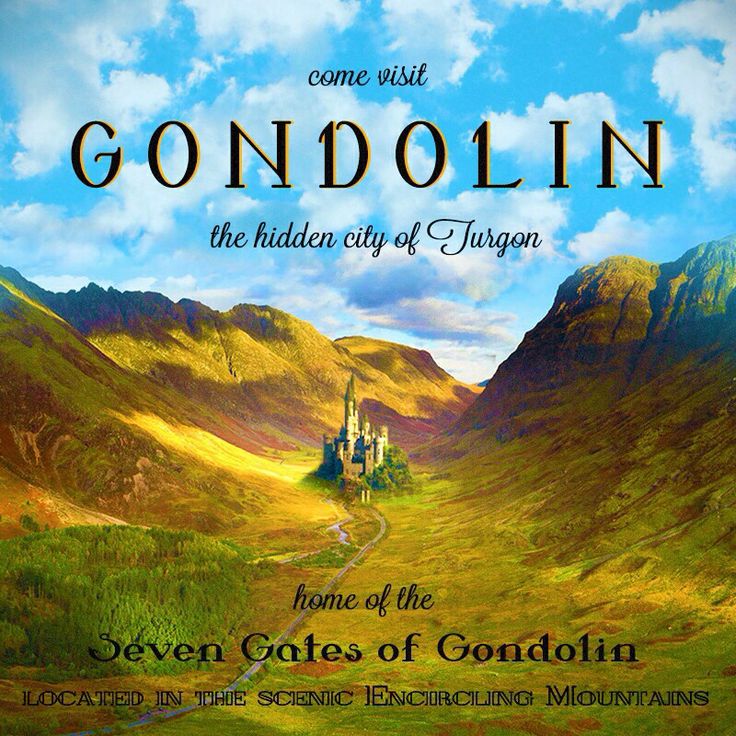
The aforementioned strangers are all Hildor(men), and I believe this is Tolkien signaling the start of the diminishing of the Quendi(elves) in Middle-earth and the reign of Men beginning. Each of the four realms of the first age (you can bring Angband into this as well) fall by a combination of greed, stubbornness, and pride whether that is Thingol creating the mithril necklace with the Silmaril, angering his dwarf allies, or Morgoth diverting more and more of his power into his legions of fell creatures in his quest to control all of Arda; Tolkein found these character traits horrible in his own world so it’s not a great leap for these traits to bring tragedy on his characters as well.
Now let us look at some other realms of Middle-earth, specifically those of Men. One of the things that I have noticed through my reading and perhaps you have as well is that all of Tolkien’s secrecy is reserved for Elves, Dwarves, and Hobbits. We have already established that that there is nothing hidden about evil in Middle-earth through the treatise on Angband and Mordor. What about Men? Where are all their hidden realms?
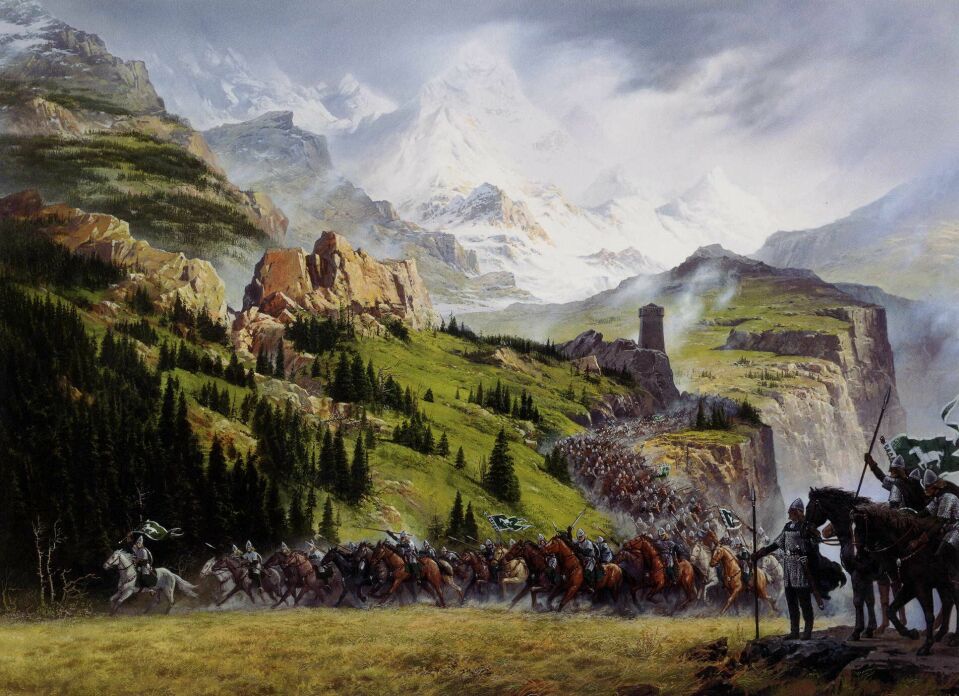
The three houses of the Edain are gifted lands in Beleriand in the first age but they are not hidden. The Men of Dorthonion and Dor-Lomin are virtually wiped out by Orcs and Easterlings and the third house in the forest of Brethil is outside of the protections of Melian and is open to attack. In the later years the two kingdoms of Men Arnor and Gondor and by extension Rohan are constantly defending themselves against attack by darkness with the northern kingdom eventually succumbing to it.
“The Gift of Men was an act of the supreme being Ilúvatar that set the race of Men apart from the Elves. While the race of Elves would know the most bliss and contentment and would conceive more beauty than any others of the Children of Ilúvatar, it was decreed by this gift that Men would be the prime instruments of Ilúvatar within Arda” JRR Tolkien, The History of Middle-earth.
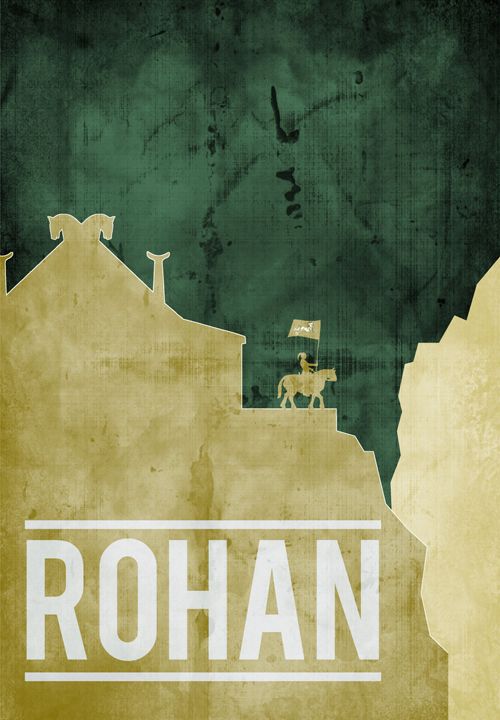 What is interesting about this relationship between the second born children of Eru and the rest of Arda is the “prime instrument” part; this is the reason that Men never have any hidden realms within Middle-earth. Men are to be a buffer against evil within the fallen world, as Tolkien believed that humans could be at their best or part of it at their worst. We see this contrast in his portrayal of the different calibers of men within his stories from the splendor and wisdom of Westerness to the failings of the Easterlings. The race of men and their role in his stories are ultimately the ones Middle-earth will be left to after the elves and other creatures have gone, and thus it is they by this process that must decide its fate. This is why Tolkien gives no hidden realms to the race of men; they must be out in the open to take part in all the events of the world, because it will be their world in the end.
What is interesting about this relationship between the second born children of Eru and the rest of Arda is the “prime instrument” part; this is the reason that Men never have any hidden realms within Middle-earth. Men are to be a buffer against evil within the fallen world, as Tolkien believed that humans could be at their best or part of it at their worst. We see this contrast in his portrayal of the different calibers of men within his stories from the splendor and wisdom of Westerness to the failings of the Easterlings. The race of men and their role in his stories are ultimately the ones Middle-earth will be left to after the elves and other creatures have gone, and thus it is they by this process that must decide its fate. This is why Tolkien gives no hidden realms to the race of men; they must be out in the open to take part in all the events of the world, because it will be their world in the end.
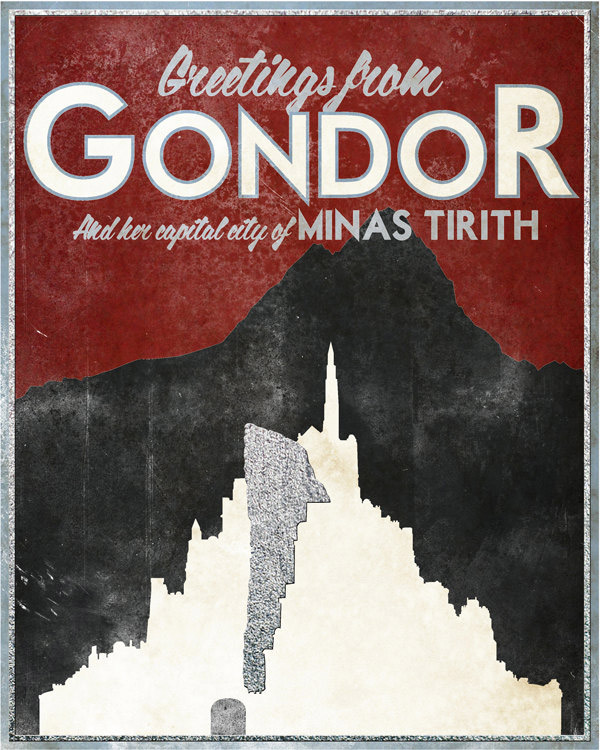
At the heart of the Middle-earth stories is the fairy tale aspect, humans cannot have hidden realms because there is nothing hidden about us, it is us that are reading the story of a wonderful and mystical world, I’m not sure that a hidden realm of Men would fit correctly or even feel like it was right. After all how could Boromir boost about keeping everyone safe by the blood of Gondor if it was hidden from the eyes of the enemy?
This essay is part one of two, in the second part we will take a look at the hidden realms of the second and third age in contrast with the dark realm of Mordor. End of part 1

Join the Discussion!!
Nice article!
Really Interesting. Good Article.